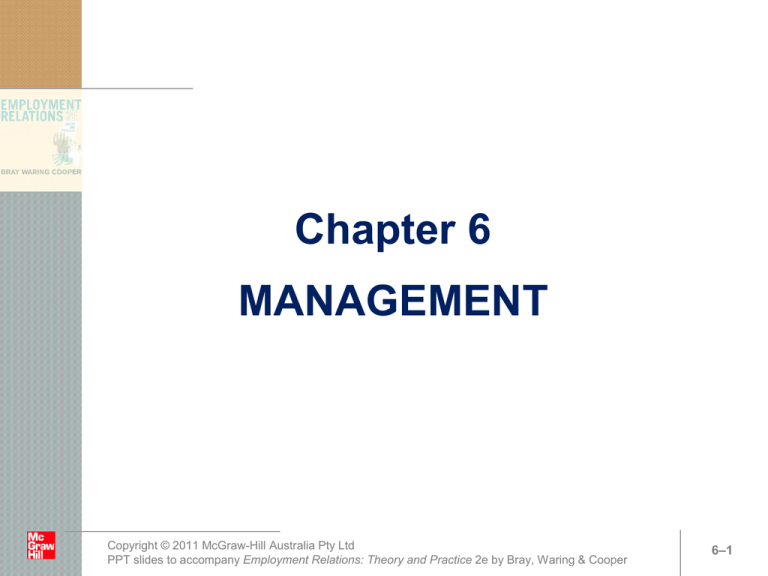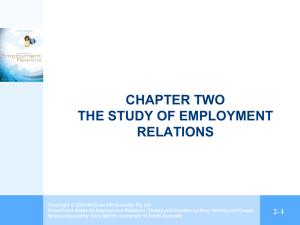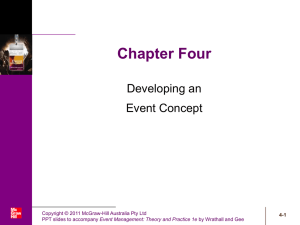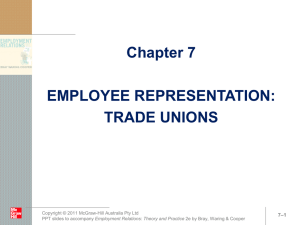Business strategies and employment relations
advertisement

Chapter 6 MANAGEMENT Copyright 2009 McGraw-Hill Australia Pty Ltd PowerPoint Slides t/a Employment Relations: Theory and Practice by Bray, Waring and Cooper Copyright © 2011 McGraw-Hill Australia Pty Ltd Slides prepared by Chris Martin, University of South Australia PPT slides to accompany Employment Relations: Theory and Practice 2e by Bray, Waring & Cooper 6–1 Learning objectives Define the term ‘management’ and locate the management of employment relations within the structure of organisations. Discuss the role of employer associations in assisting management with employment relations matters. Identify the goals and functions of management. Discuss the effect of different systems of corporate governance on employment relations. Copyright 2009 McGraw-Hill Australia Pty Ltd PowerPoint Slides t/a Employment Relations: Theory and Practice by Bray, Waring and Cooper Copyright © 2011 McGraw-Hill Australia Pty Ltd Slides prepared by Chris Martin, University of South Australia PPT slides to accompany Employment Relations: Theory and Practice 2e by Bray, Waring & Cooper 6–2 Learning objectives Distinguish between different managerial strategies to control the labour process. Describe the impact of business strategies on employment relations practices. Outline the reasons why employment relations policies are often not integrated with business strategies. Identify how different ‘management styles’ may affect the conduct of employment relations. Copyright 2009 McGraw-Hill Australia Pty Ltd PowerPoint Slides t/a Employment Relations: Theory and Practice by Bray, Waring and Cooper Copyright © 2011 McGraw-Hill Australia Pty Ltd Slides prepared by Chris Martin, University of South Australia PPT slides to accompany Employment Relations: Theory and Practice 2e by Bray, Waring & Cooper 6–3 Overview • Structures for the management of employment relations • Resources and staff • The division of responsibilities • The role of employer associations • Goals and functions of management • The management of labour • Management control strategies • Business strategies and employment relations • Evidence on managerial practices • Understanding management practices • Managerial style and attitudes Copyright 2009 McGraw-Hill Australia Pty Ltd PowerPoint Slides t/a Employment Relations: Theory and Practice by Bray, Waring and Cooper Copyright © 2011 McGraw-Hill Australia Pty Ltd Slides prepared by Chris Martin, University of South Australia PPT slides to accompany Employment Relations: Theory and Practice 2e by Bray, Waring & Cooper 6–4 Goals and functions of management • Why study management? – A more assertive approach in recent years: • international competition • labour costs • flexibility – Employers have choices: • subject to some external constraints Copyright 2009 McGraw-Hill Australia Pty Ltd PowerPoint Slides t/a Employment Relations: Theory and Practice by Bray, Waring and Cooper Copyright © 2011 McGraw-Hill Australia Pty Ltd Slides prepared by Chris Martin, University of South Australia PPT slides to accompany Employment Relations: Theory and Practice 2e by Bray, Waring & Cooper 6–5 Goals and functions of management • Management policies and practices need to be understood within the broader context of business objectives. • Much debate about: – separation of ownership from control – implications for organisational goals – reassertion of shareholder control • Forms of ownership and control: – Anglo–American/Australasian ‘outsider’ system – Continental European/Japanese ‘insider’ system Copyright 2009 McGraw-Hill Australia Pty Ltd PowerPoint Slides t/a Employment Relations: Theory and Practice by Bray, Waring and Cooper Copyright © 2011 McGraw-Hill Australia Pty Ltd Slides prepared by Chris Martin, University of South Australia PPT slides to accompany Employment Relations: Theory and Practice 2e by Bray, Waring & Cooper 6–6 Management of labour • Management’s role is to combine, allocate and utilise resources to achieve organisational objectives. • Labour resources: – converting labour power into productive labour – structures of control/methods of consent – underlying conflict of interests • Use of specialists by the organisation to manage employees and their unions. Copyright 2009 McGraw-Hill Australia Pty Ltd PowerPoint Slides t/a Employment Relations: Theory and Practice by Bray, Waring and Cooper Copyright © 2011 McGraw-Hill Australia Pty Ltd Slides prepared by Chris Martin, University of South Australia PPT slides to accompany Employment Relations: Theory and Practice 2e by Bray, Waring & Cooper 6–7 Management control strategies • Basic difficulty for management: the open-ended nature of the employment relationship. • Categorisation of strategies: – Direct control: • tight supervision • minimum of industrial discretion – Responsible autonomy: • workers have status and autonomy • discretion at work Copyright 2009 McGraw-Hill Australia Pty Ltd PowerPoint Slides t/a Employment Relations: Theory and Practice by Bray, Waring and Cooper Copyright © 2011 McGraw-Hill Australia Pty Ltd Slides prepared by Chris Martin, University of South Australia PPT slides to accompany Employment Relations: Theory and Practice 2e by Bray, Waring & Cooper 6–8 Management control strategies • Forms of control – Personalised control: workers under the direct and personalised control of supervisors. – Technical control: work design and production system─ – limits worker discretion – sets the pace for worker effort – identifies poor performance – Bureaucratic control: controls embedded in a system of─ – work rules – company policy – rewards – Commitment-based control: selection and cultivation of worker discretionary efforts to be better aligned with the organisation’s interests. Copyright 2009 McGraw-Hill Australia Pty Ltd PowerPoint Slides t/a Employment Relations: Theory and Practice by Bray, Waring and Cooper Copyright © 2011 McGraw-Hill Australia Pty Ltd Slides prepared by Chris Martin, University of South Australia PPT slides to accompany Employment Relations: Theory and Practice 2e by Bray, Waring & Cooper 6–9 Management control strategies • Management’s choice of strategy is influenced by a variety of factors, including: • employee acceptance/resistance • state regulation • market forces Copyright 2009 McGraw-Hill Australia Pty Ltd PowerPoint Slides t/a Employment Relations: Theory and Practice by Bray, Waring and Cooper Copyright © 2011 McGraw-Hill Australia Pty Ltd Slides prepared by Chris Martin, University of South Australia PPT slides to accompany Employment Relations: Theory and Practice 2e by Bray, Waring & Cooper 6–10 Business strategies and employment relations • Business-level strategies impact on the management of labour. • Porter’s three types of business strategies: 1. Innovation (or product differentiation) strategy 2. Quality-enhancement strategy 3. Cost-reduction strategy Copyright 2009 McGraw-Hill Australia Pty Ltd PowerPoint Slides t/a Employment Relations: Theory and Practice by Bray, Waring and Cooper Copyright © 2011 McGraw-Hill Australia Pty Ltd Slides prepared by Chris Martin, University of South Australia PPT slides to accompany Employment Relations: Theory and Practice 2e by Bray, Waring & Cooper 6–11 Management control strategies Copyright 2009 McGraw-Hill Australia Pty Ltd PowerPoint Slides t/a Employment Relations: Theory and Practice by Bray, Waring and Cooper Copyright © 2011 McGraw-Hill Australia Pty Ltd Slides prepared by Chris Martin, University of South Australia PPT slides to accompany Employment Relations: Theory and Practice 2e by Bray, Waring & Cooper 6–12 Business strategies and employment relations • Implications of innovation strategy – Jobs require close interaction among groups of individuals – Performance appraisals emphasise group-based achievements – Emphasis on skill development – Importance attached to internal pay equity – Employees as stockholders – Broad career paths Copyright 2009 McGraw-Hill Australia Pty Ltd PowerPoint Slides t/a Employment Relations: Theory and Practice by Bray, Waring and Cooper Copyright © 2011 McGraw-Hill Australia Pty Ltd Slides prepared by Chris Martin, University of South Australia PPT slides to accompany Employment Relations: Theory and Practice 2e by Bray, Waring & Cooper 6–13 Business strategies and employment relations • Implications of a quality-enhancement strategy – High levels of employee participation – Individual and group criteria used in performance appraisal – Egalitarian treatment of employees – Ongoing training and development of employees Copyright 2009 McGraw-Hill Australia Pty Ltd PowerPoint Slides t/a Employment Relations: Theory and Practice by Bray, Waring and Cooper Copyright © 2011 McGraw-Hill Australia Pty Ltd Slides prepared by Chris Martin, University of South Australia PPT slides to accompany Employment Relations: Theory and Practice 2e by Bray, Waring & Cooper 6–14 Business strategies and employment relations • Implications of a cost-reduction strategy – Explicit, tight job descriptions – Narrow, specialised jobs – Short-term results orientation – Emphasis on market pay – Little employee training and development Copyright 2009 McGraw-Hill Australia Pty Ltd PowerPoint Slides t/a Employment Relations: Theory and Practice by Bray, Waring and Cooper Copyright © 2011 McGraw-Hill Australia Pty Ltd Slides prepared by Chris Martin, University of South Australia PPT slides to accompany Employment Relations: Theory and Practice 2e by Bray, Waring & Cooper 6–15 Evidence on managerial practices • From a control perspective to a commitment perspective. • Transformation of business and industrial-relations strategies: – owing to market changes – away from mass production for mass markets to specialised production for niche markets • Take-up rates of the new approach: – partial versus complete adoptions • Implication for employees: – work intensification Copyright 2009 McGraw-Hill Australia Pty Ltd PowerPoint Slides t/a Employment Relations: Theory and Practice by Bray, Waring and Cooper Copyright © 2011 McGraw-Hill Australia Pty Ltd Slides prepared by Chris Martin, University of South Australia PPT slides to accompany Employment Relations: Theory and Practice 2e by Bray, Waring & Cooper 6–16 Understanding management practices • There is limited evidence of integration of business and industrial relations strategies. Why? – Use of multiple strategies at one time. – Management’s strategies are not always consistent: • continually adapting to changing circumstances – Organisations may be unwilling to embrace change: • ‘pick and mix’ approach • bundles of practices Copyright 2009 McGraw-Hill Australia Pty Ltd PowerPoint Slides t/a Employment Relations: Theory and Practice by Bray, Waring and Cooper Copyright © 2011 McGraw-Hill Australia Pty Ltd Slides prepared by Chris Martin, University of South Australia PPT slides to accompany Employment Relations: Theory and Practice 2e by Bray, Waring & Cooper 6–17 Understanding management practices • There is limited evidence of integration of business and employment relations strategies. Why? (cont.) – Lack of ER representation at executive levels─ • limits input in strategic decisions – ER managers─ • can lack understanding of the goals of the business • may lack broader business skills Copyright 2009 McGraw-Hill Australia Pty Ltd PowerPoint Slides t/a Employment Relations: Theory and Practice by Bray, Waring and Cooper Copyright © 2011 McGraw-Hill Australia Pty Ltd Slides prepared by Chris Martin, University of South Australia PPT slides to accompany Employment Relations: Theory and Practice 2e by Bray, Waring & Cooper 6–18 Understanding management practices • Katz and Darbishire (2000) point to four types of management strategy employed across the global car industry: 1. Low-wage employment pattern: cost-control, Taylorism, high turnover and opposition to unions. 2. HRM employment pattern: corporate culture, teamwork, high wages and union substitution. 3. Japanese-oriented workplace pattern: standardisation, teamwork, seniority pay and enterprise unionism. 4. Joint team-based approach: semi-autonomous workgroups, ongoing training and development, high pay and union involvement. Copyright 2009 McGraw-Hill Australia Pty Ltd PowerPoint Slides t/a Employment Relations: Theory and Practice by Bray, Waring and Cooper Copyright © 2011 McGraw-Hill Australia Pty Ltd Slides prepared by Chris Martin, University of South Australia PPT slides to accompany Employment Relations: Theory and Practice 2e by Bray, Waring & Cooper 6–19 Understanding management practices Copyright 2009 McGraw-Hill Australia Pty Ltd PowerPoint Slides t/a Employment Relations: Theory and Practice by Bray, Waring and Cooper Copyright © 2011 McGraw-Hill Australia Pty Ltd Slides prepared by Chris Martin, University of South Australia PPT slides to accompany Employment Relations: Theory and Practice 2e by Bray, Waring & Cooper 6–20 Role of market conditions • Pressures of domestic and international competition • Emphasis on change in working hours and numerical flexibility: – definition of standards hours – growth in the use of part-time labour • Employee reactions: – reductions in earnings – unequal impact – limited career progression – access to training Copyright 2009 McGraw-Hill Australia Pty Ltd PowerPoint Slides t/a Employment Relations: Theory and Practice by Bray, Waring and Cooper Copyright © 2011 McGraw-Hill Australia Pty Ltd Slides prepared by Chris Martin, University of South Australia PPT slides to accompany Employment Relations: Theory and Practice 2e by Bray, Waring & Cooper 6–21 Managerial styles and attitudes • Importance of management values and philosophies • Two dimensions: 1. individualism 2. collectivism • Six management styles: 1. 2. 3. 4. 5. 6. sophisticated human relations paternalist traditional bargained constitutional modern paternalist sophisticated consultative • Evidence on management style Copyright 2009 McGraw-Hill Australia Pty Ltd PowerPoint Slides t/a Employment Relations: Theory and Practice by Bray, Waring and Cooper Copyright © 2011 McGraw-Hill Australia Pty Ltd Slides prepared by Chris Martin, University of South Australia PPT slides to accompany Employment Relations: Theory and Practice 2e by Bray, Waring & Cooper 6–22 Managerial styles and attitudes Source : Purcell and Ahlstrand (1994, p.189). Copyright 2009 McGraw-Hill Australia Pty Ltd PowerPoint Slides t/a Employment Relations: Theory and Practice by Bray, Waring and Cooper Copyright © 2011 McGraw-Hill Australia Pty Ltd Slides prepared by Chris Martin, University of South Australia PPT slides to accompany Employment Relations: Theory and Practice 2e by Bray, Waring & Cooper 6–23 Managerial styles and attitudes • Two dimensions 1. ‘individualism’—emphasis on the employee 2. ‘collectivism’—emphasis on employees as a group • Individualism ranges from nurturing of individual employees through to commodification • Extent of collectivism is measured by: – extent, form and level of employee participation – degree of managerial acceptance of employee representation Copyright 2009 McGraw-Hill Australia Pty Ltd PowerPoint Slides t/a Employment Relations: Theory and Practice by Bray, Waring and Cooper Copyright © 2011 McGraw-Hill Australia Pty Ltd Slides prepared by Chris Martin, University of South Australia PPT slides to accompany Employment Relations: Theory and Practice 2e by Bray, Waring & Cooper 6–24 Managerial styles and attitudes • Six management styles – Unitarist/Non-collectivist styles: 1. ‘sophisticated human relations’: employees are a resource to be developed 2. ‘paternalist’: ▪ union avoidance ▪ emphasis on welfare and stability 3. ‘traditional’: employees are a cost to be minimised Copyright 2009 McGraw-Hill Australia Pty Ltd PowerPoint Slides t/a Employment Relations: Theory and Practice by Bray, Waring and Cooper Copyright © 2011 McGraw-Hill Australia Pty Ltd Slides prepared by Chris Martin, University of South Australia PPT slides to accompany Employment Relations: Theory and Practice 2e by Bray, Waring & Cooper 6–25 Managerial styles and attitudes (cont.) • Six management styles – Collectivist styles (i.e. recognise trade unions): 4. ‘bargained constitutional’: development of rules, policies and procedures to closely define the relationship 5. ‘modern paternalist’: paternalist approach but with unions recognised stress on developing cooperative relationships 6. ‘sophisticated consultative’: sophisticated human relations approach supplemented by structured consultative approaches Copyright 2009 McGraw-Hill Australia Pty Ltd PowerPoint Slides t/a Employment Relations: Theory and Practice by Bray, Waring and Cooper Copyright © 2011 McGraw-Hill Australia Pty Ltd Slides prepared by Chris Martin, University of South Australia PPT slides to accompany Employment Relations: Theory and Practice 2e by Bray, Waring & Cooper 6–26 Managerial styles and attitudes • Evidence of management style – There has been little research on management style in Australia, but: • little management interest in dealing with unions • management attitudes affect the presence or absence of unions in the workplace Copyright 2009 McGraw-Hill Australia Pty Ltd PowerPoint Slides t/a Employment Relations: Theory and Practice by Bray, Waring and Cooper Copyright © 2011 McGraw-Hill Australia Pty Ltd Slides prepared by Chris Martin, University of South Australia PPT slides to accompany Employment Relations: Theory and Practice 2e by Bray, Waring & Cooper 6–27 Managerial styles and attitudes • Factors impacting on management style 1. Need to maintain relations with employees: • removing union workplace presence may harm ongoing relationship with employees 2. Cultural factors (organisational and national): • distinct approaches between organisations • distinct approaches between nations 3. State regulation 4. Product-market and labour-market conditions: • competition based on price, innovation or quality • labour shortage or oversupply Copyright 2009 McGraw-Hill Australia Pty Ltd PowerPoint Slides t/a Employment Relations: Theory and Practice by Bray, Waring and Cooper Copyright © 2011 McGraw-Hill Australia Pty Ltd Slides prepared by Chris Martin, University of South Australia PPT slides to accompany Employment Relations: Theory and Practice 2e by Bray, Waring & Cooper 6–28 Structures for the management of ER • Two aspects 1. Resources and staff: • larger organisations are more likely to have specialists 2. Division of responsibilities: • centralisation versus decentralisation • corporate function Copyright 2009 McGraw-Hill Australia Pty Ltd PowerPoint Slides t/a Employment Relations: Theory and Practice by Bray, Waring and Cooper Copyright © 2011 McGraw-Hill Australia Pty Ltd Slides prepared by Chris Martin, University of South Australia PPT slides to accompany Employment Relations: Theory and Practice 2e by Bray, Waring & Cooper 6–29 Final observations • Research into management’s role in ER has refocussed our understanding of the processes involved in employment regulation: – labour-process theorists led this development • Increased management interest in IR is due to changes in broader business context: – increasing international competition – increased need to align IR/HR strategies with business strategies • Wide range of management practices: – employer behaviour is not clearly understood – varies between industries and nations, and within organisations Copyright 2009 McGraw-Hill Australia Pty Ltd PowerPoint Slides t/a Employment Relations: Theory and Practice by Bray, Waring and Cooper Copyright © 2011 McGraw-Hill Australia Pty Ltd Slides prepared by Chris Martin, University of South Australia PPT slides to accompany Employment Relations: Theory and Practice 2e by Bray, Waring & Cooper 6–30 Summary • ‘Management style’ refers to the guiding principles for management ER approach. • Managers and organisations possess degrees of choice in the conduct of ER, but it is shaped by: – business objectives – market conditions • Modern organisations typically have a separation of ownership from control. • Australian management more assertive in past two decades. Copyright 2009 McGraw-Hill Australia Pty Ltd PowerPoint Slides t/a Employment Relations: Theory and Practice by Bray, Waring and Cooper Copyright © 2011 McGraw-Hill Australia Pty Ltd Slides prepared by Chris Martin, University of South Australia PPT slides to accompany Employment Relations: Theory and Practice 2e by Bray, Waring & Cooper 6–31








